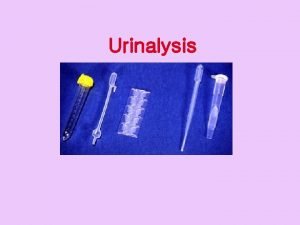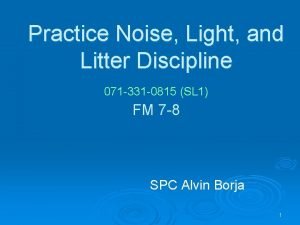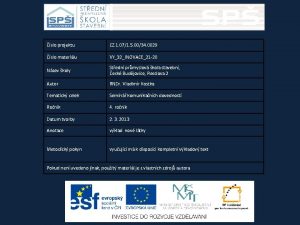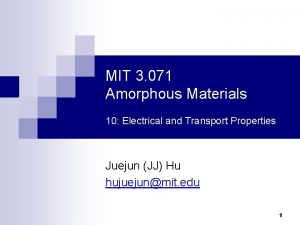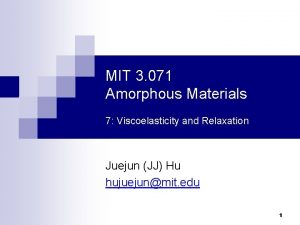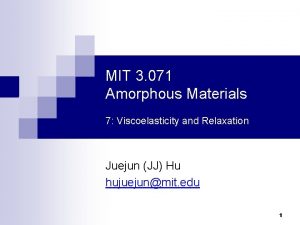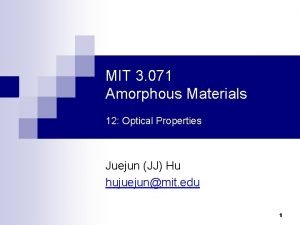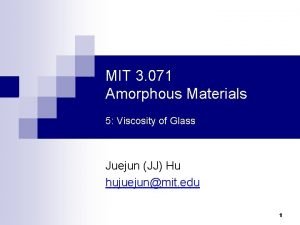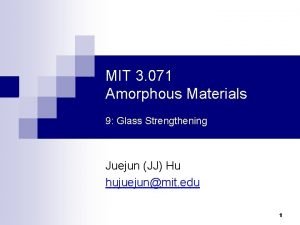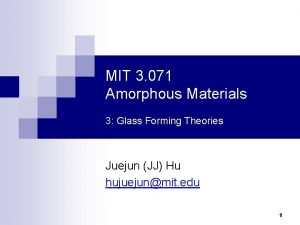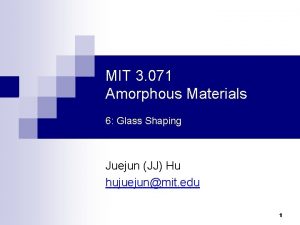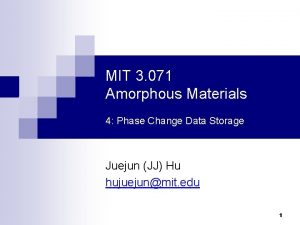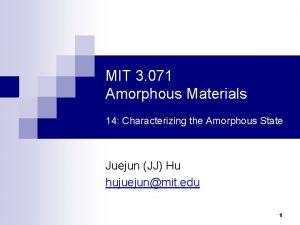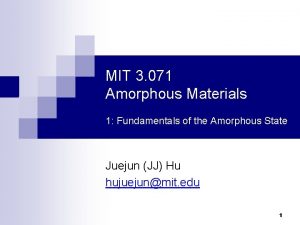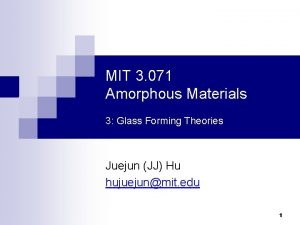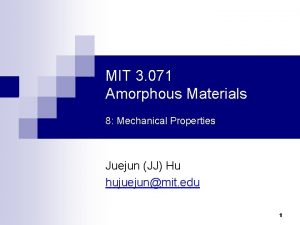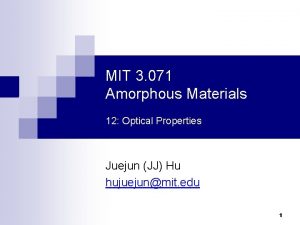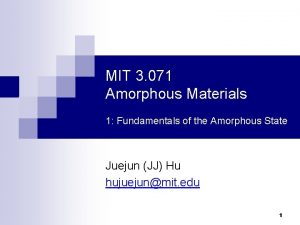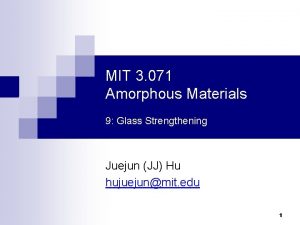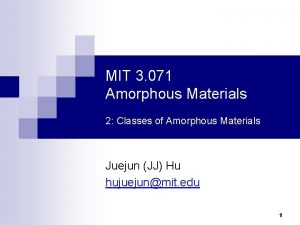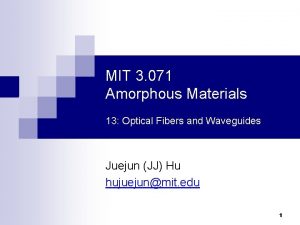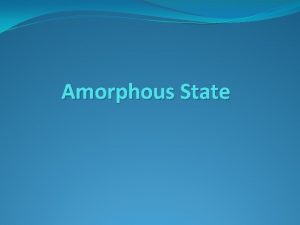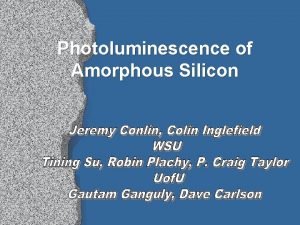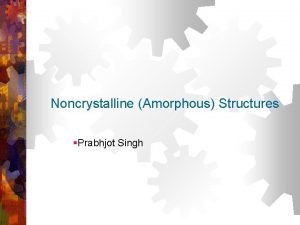MIT 3 071 Amorphous Materials 10 Electrical and


























- Slides: 26

MIT 3. 071 Amorphous Materials 10: Electrical and Transport Properties Juejun (JJ) Hu hujuejun@mit. edu 1

After-class reading list n Fundamentals of Inorganic Glasses ¨ n Ch. 14, Ch. 16 Introduction to Glass Science and Technology ¨ Ch. 8 n 3. 022 ionic conductivity n 3. 024 band gap, band diagram, engineering conductivity 2

Basics of electrical conduction n Electrical conductivity s : electrical conductivity n : charge carrier density Z : charge number e : elementary charge m : carrier mobility n Einstein relation D : diffusion coefficient v : carrier drift velocity E : applied electric field Both ions and electrons contribute to electrical conductivity in glasses 3

Ionic conduction in crystalline materials Vacancy mechanism Interstitial mechanism 4

Ionic conduction pathway in amorphous solids n There are low energy “sites” where ions preferentially locate n Ionic conduction results from ion transfer between these sites n Ionic conduction is thermally activated 2 -D slices of regions with Li site energies below a threshold value in Li 2 O-Si. O 2 glasses Phys. Chem. Phys. 11, 3210 (2009) 5

A tale of two valleys n Electric field E = 0 Assuming completely random hops, the average total distance an ion moves after M hops in 1 -D is: + n Average diffusion distance: Average spacing between adjacent sites: d (1 -D) (3 -D) n For correlated hops: (1 -D) (3 -D) Ion hopping frequency: n 6

A tale of two valleys n Attempt (vibration) frequency: n 0 n Frequency of successful hops (ion hopping frequency): Electric field E = 0 + Barrier height DEa n Equal probability of hopping along all directions: zero net current 7

A tale of two valleys n Energy difference between adjacent sites: Ze. Ed n Hopping frequency → : Electric field E > 0 DEa + Ze. Ed n Hopping frequency ← : n Net ion drift velocity: 8

A tale of two valleys n Electric field E > 0 Ion mobility DEa n n Electrical conductivity (1 -D, random hop) + Ze. Ed Einstein relation (3 -D, correlated hops) 9

Temperature dependence of ionic conductivity Dispersion of activation energy in amorphous solids leads to slight non-Arrhenius behavior 1/T (× 1, 000) (K-1) Phys. Rev. Lett. 109, 075901 (2012) 10

Ionic conductivity in soda-lime glass 11

Theoretical ionic conductivity limit in glass Note that s 0 has a unit of W·cm·K n When T → ∞, s → s 0 /T n Extrapolation of the Arrhenius plot agrees with infrared spectroscopic measurements in ionic liquids (molten salts) Solid State Ionics 18&19, 72 (1986) Annu. Rev. Phys. Chem. 43, 693 (1992) 12

Fast ion conductors / superionic conductors Acta Mater. 61, 759 (2013) 13

Band structures in defect-free crystalline solids ü All electronic states are labeled with real Bloch wave vectors k signaling translational symmetry ü All electronic states are extended states ü No extended states exist in the band gap 14

Band structures in defect-free crystalline solids In the band gap, wave equation solutions have complex wave vectors k Kittel, Introduction to Solid State Physics, Ch. 7 15

Anderson localization in disordered systems n Localization criterion: V 0 / J > 3 P. W. Anderson Disorder leads to (electron, photon, etc. ) wave function localization 16

Anderson localization in disordered systems Extended states (Bloch states) Localized states 17

Density of states (DOS) in crystalline and amorphous solids E E Conduction band Defect states Band gap Conduction band Urbach tail Mid-gap states Mobility edge Valence band DOS Crystalline solids DOS Amorphous solids 18

Tauc gap and Tauc plots n Tauc gap ET definition: n It is merely a fitting parameter and has little physical significance! a – absorption coefficient ħw – photon energy ET = 3. 3 e. V 19

Extended state conduction n Extended state conductivity: Electron drift mobility in a-Si: H m 0 : free mobility ftrap : fraction of time in trap states n Drift mobility mex increases with temperature (T → ∞, ftrap → 0) n Extended state conductivity follows Arrhenius dependence Electron mobility in c-Si: 1400 cm 2 V-1 s-1 R. Street, Hydrogenated Amorphous Silicon, Ch. 7 20

Hopping conduction via localized states n Fixed range hopping: hopping between nearest neighbors ¨ n Hopping between dopant atoms at low temperature Variable range hopping (VRH) ¨ E Hopping between localized states near EF Mobility edge EF R y x g DOS z 21

Variable range hopping n Hopping probability n Within distance R, the average minimal energy difference DE is: n Optimal hopping distance: R y x z 22

DC conductivity in amorphous semiconductors lns Extended state conduction VRH is most pronounced at low temperature Measured DC conductivity Variable range hopping 1/T 23

VRH in As-Se-Te-Cu glass ü Near room temperature, mixed ionic and extended state conduction ü At low temperature, variable range hopping dominates J. Appl. Phys. 101, 063520 (2007) 24

Summary n n Basics of electrical transport ¨ Conductivity: scalar sum of ionic and electronic contributions ¨ Einstein relation Ionic conductivity ¨ Occurs through ion hopping between different preferred “sites” ¨ Thermally activated process and non-Arrhenius behavior 25

Summary n n n Electronic structure of amorphous semiconductors ¨ Anderson localization: extended vs. localized states ¨ Density of states ¨ Mobility edge ¨ Band tail and mid-gap states Extended state conduction ¨ Free vs. drift mobility ¨ Thermally activated process Localized state conduction ¨ Fixed vs. variable range hopping ¨ Mott’s T -1/4 law of VRH E Conduction band Urbach tail Mid-gap states Mobility edge Valence band DOS 26
 Crystalline vs amorphous
Crystalline vs amorphous Example of crystalline solid
Example of crystalline solid Crystal solid and amorphous solid
Crystal solid and amorphous solid Crystalline solid and amorphous solid
Crystalline solid and amorphous solid Anisotropic
Anisotropic Trichomonas in urine
Trichomonas in urine Packing efficiency of hcp
Packing efficiency of hcp To overwhelm; to surround and attack
To overwhelm; to surround and attack Amorphous pronunciation
Amorphous pronunciation Amorphous disk mark
Amorphous disk mark Amorphous urate
Amorphous urate Amorphous
Amorphous Centrifuged
Centrifuged Tools and materials in making electrical gadgets
Tools and materials in making electrical gadgets React to indirect fire
React to indirect fire Practice noise light and litter discipline powerpoint
Practice noise light and litter discipline powerpoint Pb 071
Pb 071 What is a draw terrain feature
What is a draw terrain feature 071 atm code
071 atm code 071-com-0804
071-com-0804 Pb 071
Pb 071 N 3^071
N 3^071 Employ hand grenades
Employ hand grenades 071-com-0029
071-com-0029 071-com-4407
071-com-4407 ?3305501049 0000 28|.|091 27|.|071 98|.|553 102|.|311 13`
?3305501049 0000 28|.|091 27|.|071 98|.|553 102|.|311 13` Principles of wires
Principles of wires










